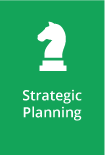IT Budgeting
IT budgeting starts with planning, which is why it is usually tied into our Strategic Alignment services and IT Roadmap , or into a Virtual CIO bundle. The goal is to tie IT spending to company strategy.
The first step is to divide your Technology budget into a few key categories:
• Run:
These are the costs to run your day-to-day IT systems and applications, and to support your users. For instance: Costs for computer purchases, server hardware and software refreshes, and day-to-day support costs.
• Grow:
These are costs to support expected growth and change in your company, or which can help support sales or marketing initiatives. In the beginning, these types of initiatives are often necessary to ‘fix’ pre-existing problems. For instance: An upgraded virtual server or cloud environment that allows for growth or less likelihood of outages; an upgraded firewall to reduce security risks; a new website that makes it easier to interact with potential customers.
• Transform:
These are costs to support strategic initiatives or research and development, for instance new products or entirely new marketing strategies; or changes to company workflow that dramatically increase productivity. For instance: A new database and data visualization system that allows for a new client-facing product; a Customer Relationship Management system that integrates with your Website and allows for full tracking of the sales process from lead to followup to quote to sales; New integration or automation systems that could dramatically improve company productivity.
White Mountain can help with the entire process, we start off by looking at your current IT systems and budget, in order to put together the ‘Run’ portion of the budget. We’ll review whether it makes sense to move your company to a Managed Services plan for your day-to-day IT service and support. Instead of traditional Time and Materials pricing, these plans provide support under a flat-rate contract. This helps transfer business risks to your IT provider, and gives them incentive to work proactively to reduce IT problems, since problems come out of their bottom line, rather than yours
Next, we use the information we gathered in the Strategic Alignment process to put together a list of Grow and Transform initiatives that mesh with your company’s Business Strategy. We also prioritize these projects based on Business Goals. Then, we go through a process to scope these projects to in order to get estimated costs, so we can compare these costs against expected gains or potential risks being mitigated.
Finally, we can come up with an approved IT Roadmap for the year ahead, tied to expected quarterly costs from the approved services and projects.
With certain virtual CIO plans, we also tie these single-year plans to multi-year budgets, and help you monitor your IT spending as we go to ensure that run-rates match your expected budget over time.
At the end of the day, you need to make the best use of your company resources, and to match Technology investments to what is most important for your busines. Using the budgeting process to help meet that goal is just like turning on your headlights. Happy driving!
Planning & Consulting
Professional IT Management
Engineering & Support






